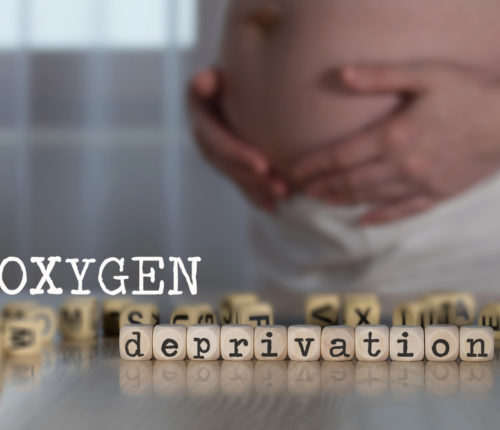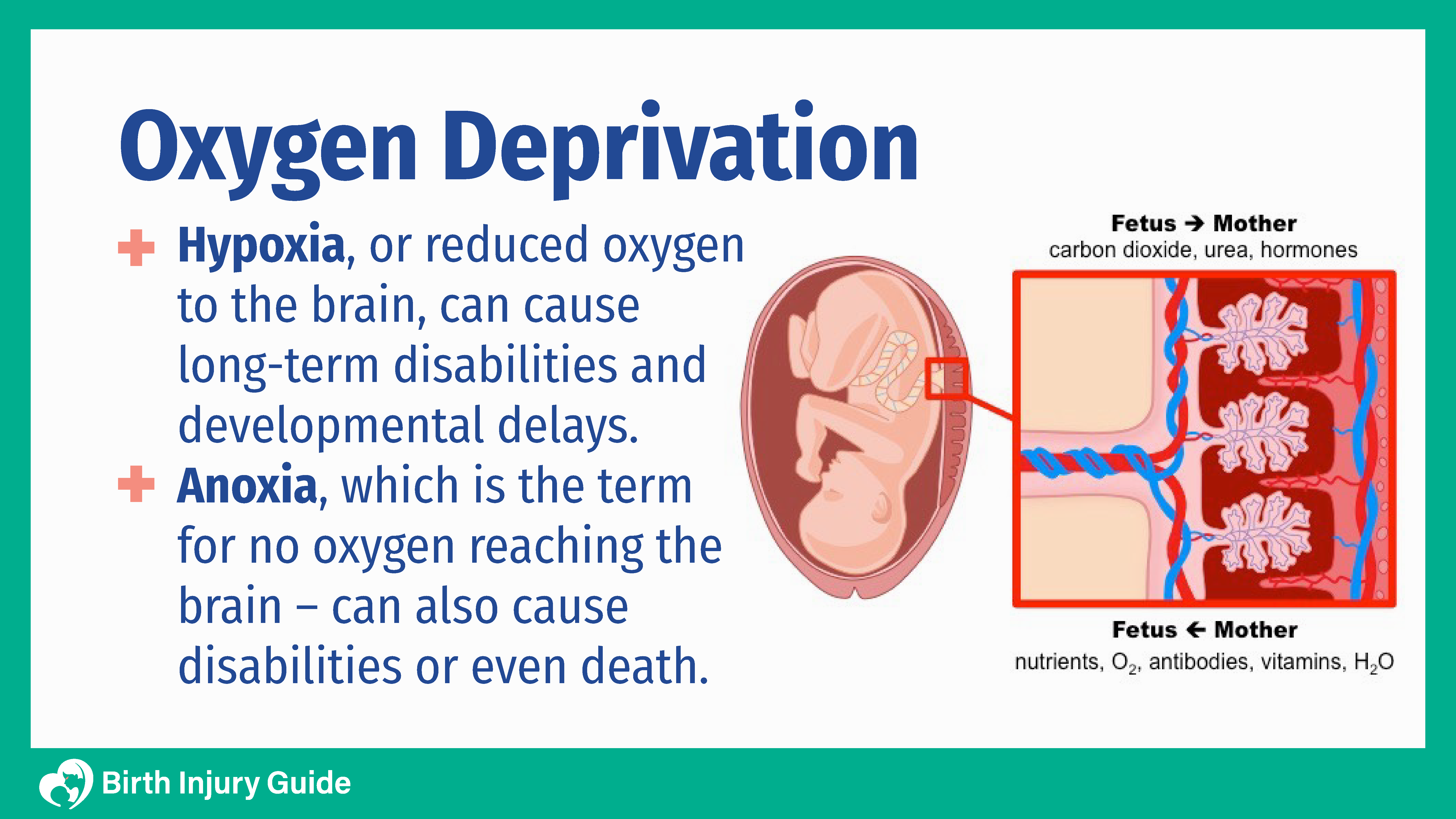
Oxygen Deprivation at Birth
Advances in medicine and medical training has helped childbirth become safer than ever for mother and baby. Unfortunately, complications still happen, and the consequences can be devastating. Oxygen deprivation at birth, also known as birth asphyxia (as-FIX-ee-uh), is one of the more common complications that occur during childbirth. Oxygen deprivation is a significant risk for babies during the labor and delivery process, and can lead to hypoxic ischemic encephalopathy (HIE), which can cause severe brain damage, developmental delays or even death.
According to the American Journal of Neuroradiology, birth asphyxia occurs in as many as 10 out of every 1,000 births. Sometimes these birth injuries are the result of a complication of pregnancy, labor and/or delivery. But many of these cases are the result of brain damage caused by medical negligence, or improper prenatal and perinatal medical care.

Two Types of Oxygen Deprivation
There are two primary types of oxygen deprivation – anoxia and hypoxia. Lack of oxygen to the baby’s brain at birth can have long-term effects for the infant and their family. Hypoxia or anoxia can cause brain damage with long-term medical consequences. The difference between anoxia and hypoxia are:
- Anoxia: Anoxia occurs when oxygen to the brain is completely cut off for a period of time.
- Hypoxia: Hypoxia occurs when oxygen levels are restricted, but the baby does receive some oxygen flow.
When oxygen is restricted, the baby’s brain cells become damaged. This brain damage can occur quickly, and without restoring oxygen, brain cells may begin to die. In the most severe cases, oxygen deprivation can be fatal. Anoxia and hypoxia both can cause long-term medical conditions, including permanent brain damage and cerebral palsy.
Causes of Lack of Oxygen at Birth
Lack of oxygen at birth can be caused by several factors, or by a combination of unfortunate circumstances. Some of these causes are unavoidable complications that no one could anticipate. However, there are also some cases where injuries could be prevented had healthcare providers taken action more quickly during signs of distress.
The most common problems leading to a lack of oxygen include:
- Trauma to the infant in utero
- Placenta issues such as placental abruption or a ruptured placenta
- Umbilical cord prolapse
- Umbilical cord compression
- Nuchal cord (umbilical cord is wrapped around the baby’s neck)
- Preeclampsia and eclampsia
- Excessive medication of the mother
- Recreational drug use by the mother
- Shoulder dystocia
- Prolonged and/or difficult labor
While some of the causes may be out of the control of healthcare providers, obstetricians, midwives and gynecologists, your healthcare team is specially trained to manage labor and delivery, including recognizing problems. Failure to quickly recognize problems and provide solutions can result in significant damage to the baby’s brain and body.
Jaundice: An Overlooked Cause of Brain Damage
Jaundice is often overlooked as a serious medical condition because it occurs so frequently in newborns. While most infants with jaundice recover without complications, there are times when jaundice escalates into a dangerous situation, potentially causing brain damage. This is one of few instances where a lack of oxygen after birth is a significant concern.
Jaundice occurs when bilirubin builds up in the bloodstream. Bilirubin is a pigment that is shed when the body breaks down red blood cells. It is processed and broken down by the liver. In babies with jaundice, however, the body doesn’t break down bilirubin properly, which is why babies have a yellow color to their skin.
If jaundice is not properly treated, excess bilirubin can begin to invade the brain and cause brain damage. This is a rare condition called kernicterus (kər-ˈnik-tə-rəs). Even though it is rare, it should not be underestimated. Jaundice is often perceived as a common and easy-to-treat condition. The reality is that it can be very dangerous if it is not properly recognized and treated in a timely manner. Kernicterus is one of the potential causes of brain damage and disorders like cerebral palsy.
Oxygen Deprivation Symptoms
When the brain is deprived of oxygen supply, the entire body can be affected. Oxygen deprivation can cause damage to the lungs, heart and muscles. Because of this, if your doctor suspects that your baby may have been deprived of oxygen, the Apgar score will be very important.
The Apgar score is a system that evaluates a newborn’s overall health, including factors like:
- Skin color
- Reflexes
- Muscle tone
- Breathing
- Heart rate
In addition to the Apgar score, your doctor will monitor your child for symptoms of a lack of oxygen to the brain at birth, such as:
- Weak reflexes
- Poor muscle tone
- Seizures
- Urinary problems
- Lethargy
- Signs of circulatory problems
- Acidosis (excess acid in the bloodstream)
If there is not an obvious birth injury, or if the injury was minor, parents and healthcare providers may not immediately recognize signs of mild oxygen deprivation. In many cases, the signs become apparent as the child ages. Because oxygen loss can cause brain damage, there may be more subtle symptoms at first without an accurate diagnosis of exactly what is going on.
Some of the common signs of oxygen deprivation at birth include:
- Poor memory
- Developmental delays
- Delayed speech
- Learning disabilities
- Behavioral problems
- Attention deficit disorder
- Autism
- Lower IQ scores
As your baby begins to approach certain milestones, you may notice delays or difficulties. In such cases, it is important to talk to your doctor about your child’s health. Oxygen loss can cause health and cognitive issues, but it can also cause other medical conditions that need monitoring and treatment. For example, oxygen deprivation at the time of birth is a known risk factor for cerebral palsy and autism.
Treating Oxygen Deprivation Injuries
It is important that infants are treated for a lack of oxygen as soon as possible. Just 10 minutes without oxygen is enough to cause brain damage. Twenty-five minutes can be fatal. By initiating treatment immediately, doctors may be able to stop additional brain damage from occurring. The most common method of doing this is neonatal therapeutic hypothermia. This is a treatment method that cools the baby’s body in a controlled environment for around 72 hours. The baby’s body temperature is lowered to around 32-34 degrees (C), or 90 to 94 degrees (F). During neonatal therapeutic hypothermia, doctors closely monitor the baby’s brain activity, metabolic rates and overall vital signs. Research shows that therapeutic hypothermia is one of the best treatment options for newborns with brain injuries.
Long-Term Effects of Lack of Oxygen at Birth
Infants with a mild brain injury due to restricted oxygen supply often respond well to treatment and recover without complications. Unfortunately, many others suffer moderate to severe brain injury, which can have a devastating impact on a child’s developing brain and vulnerable body. Adequate blood oxygen levels are what supplies nutrients to our bodies and keeps our organs functioning properly.
Lack of blood oxygen at birth can result in long-term effects that affect the child for the rest of his or her life, as well as affects the entire family. This is especially true if there is a hypoxic ischemic injury, which involves a lack of both oxygen and blood flow to the brain. In these cases, brain damage is severe and the child may experience long-term or even life-long problems.
Oxygen deprivation can lead to disabilities, such as:
- Cerebral palsy
- Autism
- Attention deficit hyperactivity disorder (ADHD)
- Seizures
- Behavioral problems
- Developmental delays
- Poor growth
- Nutritional deficiencies
Such conditions often require long-term specialized care including medication, occupational, physical and behavioral therapies, specialized educational methods and even home modification. These requirements can be financially and emotionally taxing for many families.
Financially, the lifetime costs for individuals with cerebral palsy and/or other intellectual disabilities are estimated to be close to $1 million, according to the Centers for Disease Control and Prevention (CDC). Conditions such as autism and epilepsy also may require significant financial resources in order to maintain a functioning quality of life for the individual. Similarly, a cerebral palsy prognosis could require a lot of resources.
Unlike many illnesses, the consequences of a lack of oxygen during birth most often last for a lifetime. Families facing this unfortunate circumstance who believe that medical negligence led to their child’s injuries should consider obtaining legal guidance about protection of their rights.
Can Oxygen Deprivation be Prevented?
While not every negative birth outcome can be prevented, there are things that healthcare providers can do to reduce the risk of oxygen deprivation, and in some cases, even prevent it. Doctors, nurses and midwives all receive training on birth asphyxia. Their training includes the dangers, potential risk factors and how to prevent asphyxia-related injuries.
The foremost way to prevent oxygen-related injuries is by closely monitoring mother and child during the prenatal period, and once labor and delivery begins. Any abnormalities or signs of distress should be addressed immediately. If complications arise, doctors have a duty to act in a timely manner in order to promote the best outcome possible.
Risk Factors for Birth Asphyxia
Birth asphyxia, or a lack of oxygen during labor and delivery, can be prevented if healthcare providers recognize risk factors and take action right away. Some of the risk factors for birth asphyxia that healthcare providers and expectant parents should be aware of include:
- The mother is 20-25 years old at the time of pregnancy
- The mother is pregnant with multiples (twins, triplets, etc.)
- A history of birth asphyxia during previous pregnancies
- The mother does not attend prenatal appointments
- During delivery, the fetus is positioned abnormally (breech, etc.)
- The mother has preeclampsia or eclampsia
Recognizing risk factors and adjusting prenatal or perinatal care accordingly is one of the best ways to reduce the risk of birth asphyxia. Healthcare providers must monitor women who are considered “high-risk” carefully to ensure they account for all risk factors and possible outcomes.
Can Oxygen Deprivation be a Sign of Medical Malpractice?
If a doctor, nurse or midwife fails to recognize or treat oxygen deprivation, any resulting injuries may constitute medical malpractice. In such cases, families may find it helpful to speak with a birth injury lawyer about their child’s injuries and their legal rights.
Families affected by medical malpractice may be entitled to compensation for the injuries their child has suffered. Furthermore, they may be eligible for compensation for their financial expenses, such as medical expenses, lost wages, pain and suffering and other costs. For families impacted by birth injuries – especially injuries like cerebral palsy – the financial strain can be tremendous. A medical malpractice or birth injury claim can help offset those costs and ensure that the child has access to quality care.
Start Your FREE Case Review Today
If you or your child is injured as a result of medical negligence, call us to learn more.



